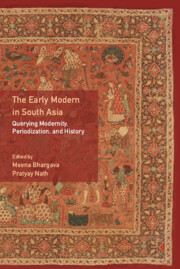7 - Through the Prism of Environmental History: Defining the Early Modern in South Asia
Published online by Cambridge University Press: 06 September 2022
Summary
As the world moved into the twenty-first century, ‘modernity’ was ‘out there for everyone to see and no questions asked’, observed Christopher A. Bayly. To begin with, there was a fair amount of consensus with Bayly's definition of modernity and its origins. But with the deepening of historical research and scholarship, that consensus has become a thing of the past. Modernity has increasingly come to be constructed in several different ways, with none attributing to it the characteristics of an objective reality or speaking of it in the ‘singular’, thus leading to ‘subjective modernities’. With the querying of ‘singular modernity’ and that ‘one-size-fits-all conception of development’ evolved the notion of early modernity in different parts of the world, pointing towards different regions pursuing alternate paths into the modern world and experiencing modernity in different ways. In the context of South Asia, a few scholars observed that India along with China led the world economy – whether in crafts, agriculture, trade and commerce – until about the middle of the eighteenth century. Not just that, India in the seventeenth century could boast of traders like Abdul Ghafoor and Virji Vora, who by themselves wielded more capital than all the East India Companies of Europe put together. In addition, reason, philosophy, and intellectualism were deeply rooted in the centuries – mid-sixteenth to the eighteenth centuries. As indicated in the introduction to this volume, this is roughly the period that has been carved out of the traditional category of the medieval period of South Asian history and has come to be identified in recent historiography as the time of early modernity.
In this chapter, I explore the nature of the early modern condition in South Asia in the domain of human–environment relationships. I argue that the period between the sixteenth to the eighteenth centuries in South Asia, like in every other part of the world, witnessed processes by which human beings vigorously intervened in the natural environment with heightened pace and magnitude of change. Early modernity in South Asia also witnessed growing population, rapidly moving anthropogenic change, and heightening effects of collective human action on the ecosystems.
- Type
- Chapter
- Information
- The Early Modern in South AsiaQuerying Modernity, Periodization, and History, pp. 141 - 160Publisher: Cambridge University PressPrint publication year: 2023



